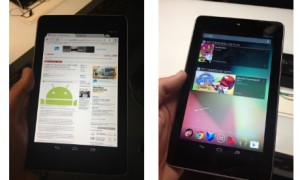New Google Nexus 7
The ASUS Nexus tablet, Google’s first tablet in the Nexus family is finally here and it’s called the Google Nexus 7. Surely you saw all of our coverage from earlier today. From the announcement post, or immediate hands-on coverage and more, but now we’re diving in a little deeper with tons of info and our initial review impressions.
Google’s new tablet is pretty impressive. Is this just a Kindle Fire fighter? Yes and no. Of course this will directly compete with the Kindle Fire – and kill it – but it also competes with all of the Android tablets currently available. Not just 7-inch models. Coming with impressive specs, the latest version of Android, and an awesome price how could it not? Below we’ll show you a few more videos, plenty of screenshots, and as usual some benchmarks of that quad-core Tegra 3 processor. Stay tuned and enjoy it all below.
This tablet certainly isn’t the thinnest 7-inch tablet in the world at 0.41?, but it’s extremely light, and the relatively soft plastic back is super comfortable to handle. This device is sized at 7.8? x 4.72? x 0.41? so you can fit it in your back pocket if you wish, and the display, at a whopping 7-inches with 1280 x 800 pixel LED-backlit IPS (216 ppi), is more than fabulous enough for your HD-loving eyeballs. For comparison’s sake – the Galaxy Tab 7.7 is 196ppi and the iPad 3 is 264ppi, so you’ve got a device that’s right up there in the big leagues.
It’s brighter than you could possibly need it to be in any average day’s activities indoors, comes in a couple different color combinations: black and black (though our Google I/O edition with a black/white combination may be a sign of things to come), and feels really nice to work with. The back-facing camera is certainly OK, but isn’t a vast improvement over anything we’ve seen before, with quality just high enough that we’ll not be taking many photos with it at all (a good thing, too, since this device does not come with a camera app installed because of its push for Google+ hangouts) and eventual Project Glass interaction.
You’ve got a bit of a hidden bonus in the fact that this is one of the only tablets on the market today that uses a standard microUSB for charging. You’ll want to use the included power converter from the package, of course, but running through that little standard port is good for everybody. The speakers are generous on their own, with a single slit running down the back for blasting, but as you’ll come to realize through this review, this device was made more for sharing to other devices. Like the brand new Google Nexus Q, introduced at Google I/O 2012 right alongside the Nexus 7.
Google Currents remains an usable alternative to Flipboard – including pulling in articles from a range of British news sites. Google’s new magazine-reading app also works well, although its value will rest on how many publishers support it, and how quickly.
YouTube, Gmail, Google Maps, Google Earth: they’ve all been smartly optimised for the 7in display. Google+ looks beautiful, with the obvious caveat that if your friends aren’t actively using it, that beauty will count for nothing.
No games were on the device, but it will be interesting to see how the Nexus 7′s quad-core CPU and 12-core GPU perform.
Judging by the demos of Horn and Dead Trigger shown during the keynote, it’s good for 3D games requiring more grunt – yet the “Who says mobile gaming has to be casual?” quote in the keynote struck a slight bum-note.
I suspect the Nexus 7′s key gaming use will be games more like Angry Birds, Cut the Rope and Draw Something, and that’s nothing to be ashamed about.
So, the Nexus 7 is a powerful device, the software is good, the store is vastly improved, and there should be plenty of content and apps available for it when it ships in July.
Google needs to work hard to get more developers to launch native Android tablet apps though – the availability of this device alongside the Kindle Fire should at least nudge a few more into putting in the effort. There is also work to do in bringing some of Google’s entertainment services to Europe, such as its cloud music service.
But it’s the price that stands out for me with the Nexus 7, at ?159 plus shipping for the 8GB version and ?199 for the 16GB model. This isn’t an iPad-killer, it’s looking to establish – together with Kindle Fire – a separate market.
For now, the Nexus 7 is being sold online from the Google Play Store. It’s unclear at this point when – or, indeed, whether – it will find its way to other online and offline retailers – something that will be important for it to find a mainstream audience.
It’s Wi-Fi rather than 3G, so there’s not an obvious operator angle, but the price may be low enough for some to bundle it when selling high-end Android smartphones.
